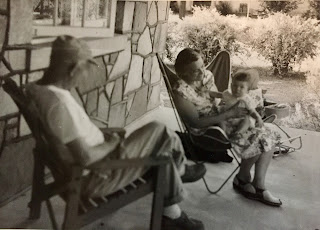

College is for control freaks. Looking back on four decades of self employment, I realize how little I appreciated the freedom to choose my classes, subject matter, and hours. Not only that, but college afforded the luxury of almost one-to-one risk/reward and input/output. Want a good grade? Apply yourself. Luck had almost nothin' to do with it.
My father worked for the government, but when a new Administration decided nuclear power was no longer worthy of research funding, he saw the writing on the wall, moved back to Missouri, got a job as a television repairman (does anyone do that anymore?) and bought a few cows. Lesson learned: jobs come and jobs go.
Farming is different. I thought I understood that when we left college to return to Blake's family's farm, but I really didn't have a clue. Even though I was raised to keep my "nose to the grindstone"and believed all that Poor Richard's Almanac stuff like "early bird gets the worm", "make hay while the sun shines", "no pain, no gain", I didn't realize that hard work and application were only part of the farming equation. The summer we married, Blake sent me some Polaroid pictures of beautiful shoulder high corn circa fourth of July, but by our wedding day in August, everyone knew it would be a short droughty crop. The next spring it rained every weekend we came home from school to help put in the crop. Instead, we worked to remodel our little house and chased cattle through sodden bottoms when they got out. Harvest that fall drug on with tractors and chains to pull the combines out of the muddy fields and finally finished with the guys chiseling icy gumbo out of wheels and other moving parts. The only reward the hard work and long hours could promise was.... an end. Eventually. Not Thanksgiving, but by Christmas.
That first winter back the dirt road across the bottom drifted higher than our car. Blake's dad made a way through...for the tractor and wagon to get feed to the cattle. Chores took all day. It was a drastic introduction to the invisible elephant in the room of our life: the weather. I thought I'd been attuned to weather before, but it became...and has remained!...the fallback subject of any casual conversation and the bedrock concern more days than not. At five past six, KMA would give the weather forecast. One Christmas my present was a satellite dish system that displayed the markets...and the radar. These days forecast.weather.gov is just a thumbprint away on the front page of my phone.
The weather doesn't care how hard you work. The weather won't wait, won't judge, and won't pat you on the back. Like Matthew 5:45 says:
"That ye may be the children of your Father which is in heaven: for he maketh his sun to rise on the evil and on the good, and sendeth rain on the just and on the unjust."
This was just a warmup, so to speak, for the plant business. For the summer afternoons and evenings we built greenhouses, for the plants that fried because we missed a spot watering or froze when the wind found a gap or got too big or stayed too small. If those plants had been animals, we would have been cited for cruelty too many times to count! Babies, of any species, are vulnerable, a truth we learned through all manner of trial and error. Diligence may not guarantee success, but it can postpone failure. There's an alarm to call when the temperature in a greenhouse gets too hot...or too cold. There's a squadron of portable heaters to deploy and generators in case of catastrophe.
We have a communal family nightmare and it involves water; did I shut the hose/hydrant off? Did I forget to water my steers? Did I miss some plugs/cuttings in a greenhouse I haven't looked at? Anyone can wake sweating from the dream that you're testing for a class you forgot you signed up for, but not everyone takes a nocturnal stroll to see if there's water running unabated from a hydrant somewhere.....
We have a communal family nightmare and it involves water; did I shut the hose/hydrant off? Did I forget to water my steers? Did I miss some plugs/cuttings in a greenhouse I haven't looked at? Anyone can wake sweating from the dream that you're testing for a class you forgot you signed up for, but not everyone takes a nocturnal stroll to see if there's water running unabated from a hydrant somewhere.....
If you grew up in outer suburbia, even if it was the borderlands, your antenna picked up 5 television stations, water always came out of the tap and a power outage was not your responsibility. This is what I took for granted growing up and what most people consider civilized. But farm life still requires a certain level of self sufficiency, MacGyver-like ingenuity, and a tolerance for both occasional lapses in personal creature comforts..and willingness to forego those for the sake of some other creature.
Sure, we work for ourselves, and our families. But we feel responsible for even more.























































